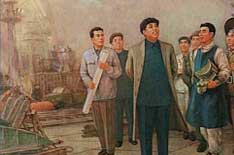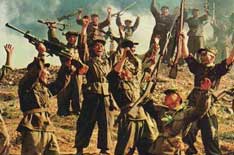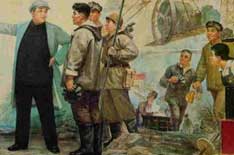
Propaganda painting of a Kim Il Sung factory tour. |
Fifty years after the conflict that killed millions, the Korean peninsula theoretically remains at war. No peace treaty has ever been signed.
U.S. bombing destroyed most of the North’s industry, agriculture, transportation, and communications systems. Pyongyang, the capital, was a pile of rubble, its buildings obliterated by an estimated 250,000 bombs the U.S. Air Force reported it dropped. Use of napalm dealt additional blows. Reports released by Pyongyang at war’s end in 1953 indicated that North Korea’s population decreased by 12 percent between 1949 and 1953.
The roughly 1.2 million people who headed South left behind not only an immense brain drain, but family. Some 10 million families are believed separated by the border between North and South, according to the South Korean Red Cross. As of 2002, a mere 5,402 families had met with their North Korean relatives. To this day, telephone and mail communication between the two states does not exist.
In the decade that followed, the DPRK, helped by abundant financial and technical aid from the USSR and China, began to rebuild. Rapid industrialization in the 1950s and 1960s put North Korea ahead of the South economically – at least, temporarily.
Nor did the North give up on its goal of reunifying the peninsula. But this time, instead of open attack, it was covert – bomb explosions, agent infiltrations, and more, all intended to eliminate South Korea’s government, seen as the dupe of American imperialism, persisted until the 1980s.
As the DPRK’s financial support from the USSR and China dwindled, though, new forms of contact were sought. Trade relations between North and South Korea were established in 1988. In the 1990s, as famine ravaged its population, killing an estimated 2 million people, Pyongyang accepted food and medicine from the South, extended as part of former South Korean President Kim Dae-jung’s “sunshine policy” of unconditional aid to North Korea. An historic summit between the South Korean leader and Kim Jong Il followed in 2000 (though allegedly North Korea made its participation conditional upon receipt of $500 million from the South).
But the North did not forget its war experiences. At July 2003 celebrations of the armistice’s 50th anniversary, North Korea was presented as both the war’s victim and victor. Behind the division of the Korean peninsula stands the U.S., Pyongyang maintains, who “prevented the peaceful settlement of the question of Korea.”
Seeing their country under constant threat of attack, North Korea responded by making the military the center of its economic effort. The Korean Workers’ Party declares that the so-called military-first policy “firmly defends independence and guarantees the interests, prosperity and development of the country and the nation.”
The country maintains a 1.1 million-troop military, the fifth largest in the world, at a cost of an estimated 31 percent of its annual GDP, according to the 2001 CIA World Factbook. Some 75 percent of this fighting force is stationed near the DMZ, the world’s most heavily armed border.

North Koreans celebrate their “victory” at war’s end. |
South Korea has followed a similar deployment route: the bulk of its 650,000-strong military is located near the DMZ. Plans are afoot, however, for U.S. troops, roughly 37,000 in 2003, to be withdrawn from the border and concentrated in bases further to the south of the peninsula.
Officially, peaceful reunification is the goal of both North and South. Even as the stand-off over North Korea’s development of nuclear weapons deepened in July 2003, plans for reunions of selected families continued. At the summit between Kim Jong Il and Kim Dae-jung, both North and South declared a goal of “one Korea.” The question remains of what that Korea will be.
- Previous: 1951-1953 Peace And Pows



